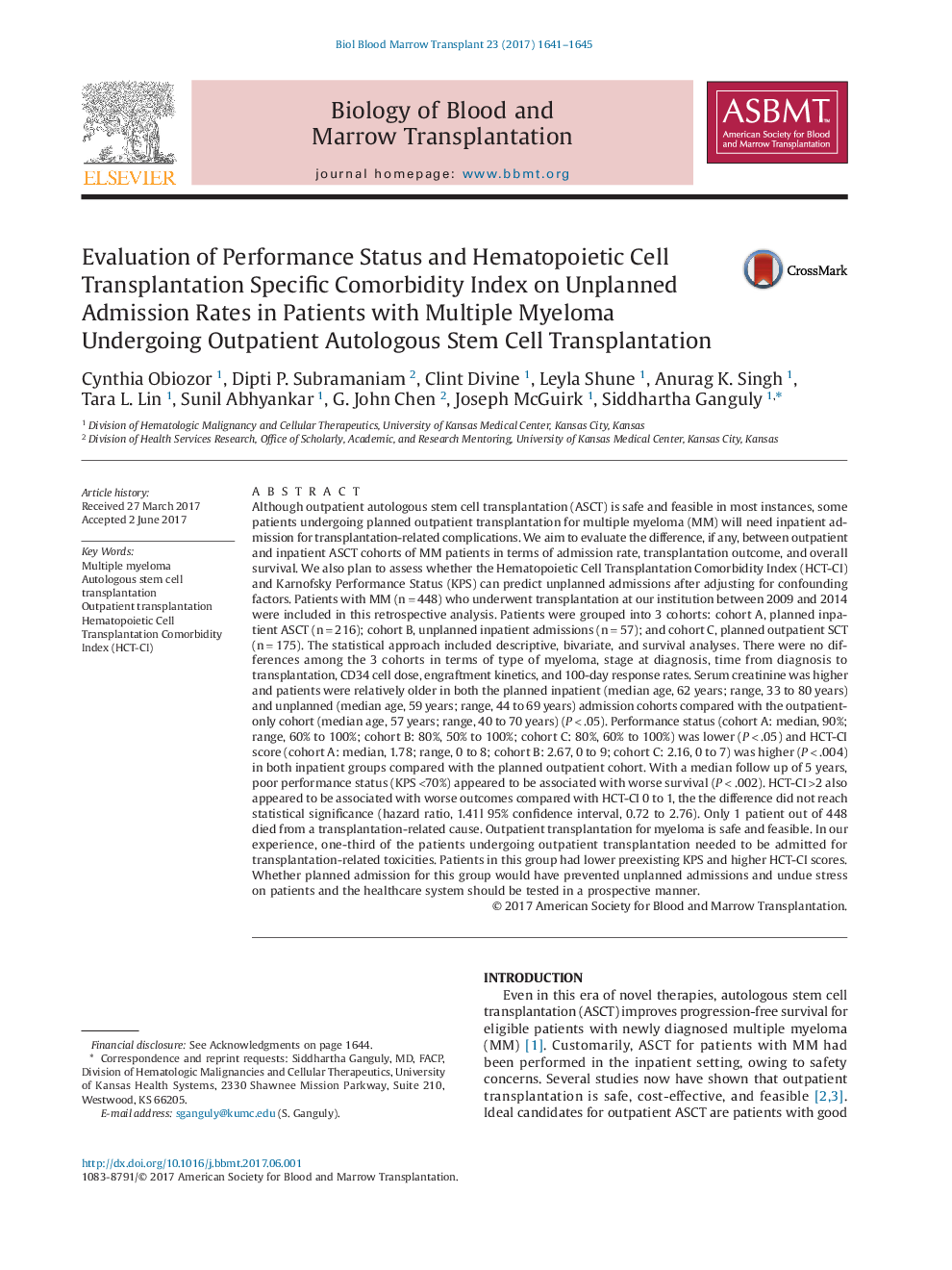| Article ID | Journal | Published Year | Pages | File Type |
|---|---|---|---|---|
| 5524048 | Biology of Blood and Marrow Transplantation | 2017 | 5 Pages |
â¢Outpatient transplantation for myeloma is safe and feasible.â¢The HCT-CI did not have significant effect on survival for this study cohort.â¢Poor performance status appeared to be associated with lower survival.â¢Patients with KPS and comorbidities are at a risk for unplanned admissions.
Although outpatient autologous stem cell transplantation (ASCT) is safe and feasible in most instances, some patients undergoing planned outpatient transplantation for multiple myeloma (MM) will need inpatient admission for transplantation-related complications. We aim to evaluate the difference, if any, between outpatient and inpatient ASCT cohorts of MM patients in terms of admission rate, transplantation outcome, and overall survival. We also plan to assess whether the Hematopoietic Cell Transplantation Comorbidity Index (HCT-CI) and Karnofsky Performance Status (KPS) can predict unplanned admissions after adjusting for confounding factors. Patients with MM (nâ=â448) who underwent transplantation at our institution between 2009 and 2014 were included in this retrospective analysis. Patients were grouped into 3 cohorts: cohort A, planned inpatient ASCT (nâ=â216); cohort B, unplanned inpatient admissions (nâ=â57); and cohort C, planned outpatient SCT (nâ=â175). The statistical approach included descriptive, bivariate, and survival analyses. There were no differences among the 3 cohorts in terms of type of myeloma, stage at diagnosis, time from diagnosis to transplantation, CD34 cell dose, engraftment kinetics, and 100-day response rates. Serum creatinine was higher and patients were relatively older in both the planned inpatient (median age, 62 years; range, 33 to 80 years) and unplanned (median age, 59 years; range, 44 to 69 years) admission cohorts compared with the outpatient-only cohort (median age, 57 years; range, 40 to 70 years) (Pâ<â.05). Performance status (cohort A: median, 90%; range, 60% to 100%; cohort B: 80%, 50% to 100%; cohort C: 80%, 60% to 100%) was lower (Pâ<â.05) and HCT-CI score (cohort A: median, 1.78; range, 0 to 8; cohort B: 2.67, 0 to 9; cohort C: 2.16, 0 to 7) was higher (Pâ<â.004) in both inpatient groups compared with the planned outpatient cohort. With a median follow up of 5 years, poor performance status (KPSâ<70%) appeared to be associated with worse survival (Pâ<â.002). HCT-CIâ>2 also appeared to be associated with worse outcomes compared with HCT-CI 0 to 1, the the difference did not reach statistical significance (hazard ratio, 1.41l 95% confidence interval, 0.72 to 2.76). Only 1 patient out of 448 died from a transplantation-related cause. Outpatient transplantation for myeloma is safe and feasible. In our experience, one-third of the patients undergoing outpatient transplantation needed to be admitted for transplantation-related toxicities. Patients in this group had lower preexisting KPS and higher HCT-CI scores. Whether planned admission for this group would have prevented unplanned admissions and undue stress on patients and the healthcare system should be tested in a prospective manner.
